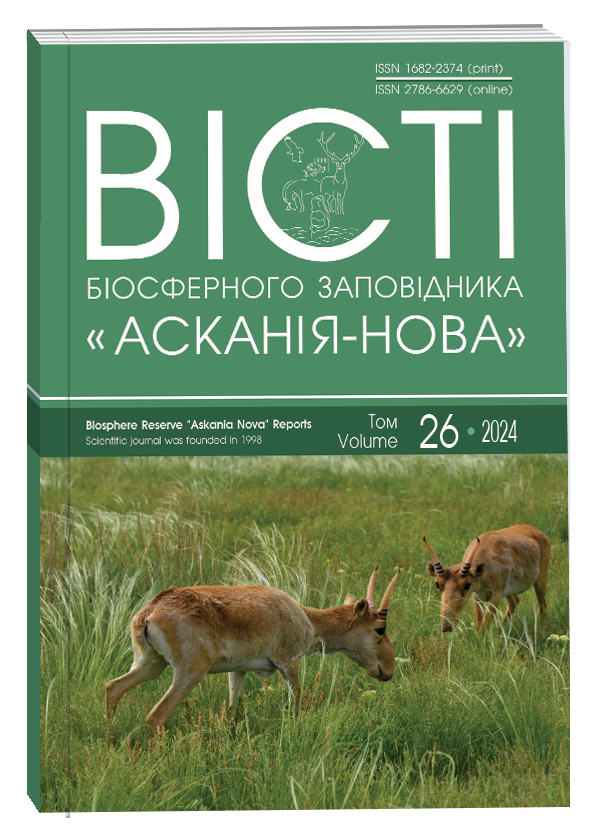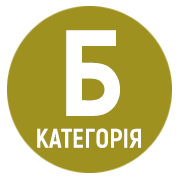FEATURES OF VEGETATION RESTORATION ON MILITARY FORTIFICATIONS IN THE CHORNOBYL RADIATION AND ECOLOGICAL BIOSPHERE RESERVE
DOI:
https://doi.org/10.53904/1682-2374/2024-26/10Keywords:
Військові фортифікації, бліндажі, окопи, фітоценози, флора, сукцесія, Чорнобиль, інвазійні видиAbstract
One of the most significant consequences of the military impact on the natural ecosystems of the Nature Reserve Fund, which causes changes in phytodiversity, is the construction of fortifications. Studying of the peculiarities of such changes and the processes of vegetation restoration in areas damaged by military operations is extremely relevant. The purpose of this study is to record the current state of the phytobiota and explore succession changes in vegetation cover in areas with microrelief disturbances due to the construction of fortifications on the territory of the Chornobyl Radiation and Ecological Biosphere Reserve. It was established that the primitive fortifications located on the territory of the Chornobyl Reserve have been experiencing an increase in plant species diversity over the past three years (from 140 species of vascular plants in 2022 to 184 species in 2023 and 191 species in 2024). The most species-rich families were Asteraceae and Poaceae. In terms of geographical distribution, species of disturbed habitats in the study area mainly belong to the Holarctic range type (83 species, 59.3%), i.e. they are widespread. At the present stage of research, the flora of these new formations is formed mainly by annuals, biennials, and perennials. Gradually, the composition of the dominants of these communities is changing, their herbaceous base is strengthening, and there is a wide dispersal of ligneous biomorphs from communities adjacent to these areas. Based on the analysis of the ecological and coenotic structure of the flora of these new formations, we found the predominance of synanthropic species among the main groups (up to 58.8%), with a significant proportion of alien taxa (14.1%). We predict a further increase in the diversity of plant species on military fortifications, with changes in the composition of communities and an increase in the number of invasive species. Further research will allow us to study the next stages of the succession processes of these landscape formations.
References
Василюк О. До чого призводять військові фортифікації в Україні. Ukraine War Environmental Consequences Work Group. URL: https://uwecworkgroup.info/uk/military-fortifications-in-ukraine-what-comes-next/
Голубцов О., Сорокіна Л., Сплодитель А., Чумаченко С. Вплив війни росії проти України на стан українських ґрунтів. Результати аналізу. Київ : ГО "Центр екологічних ініціатив "Екодія". 2023. 32 с.
Дідух Я.П. Етюди фітоекології. Київ : Арістей, 2008. 268 с.
Дідух Я.П., Соколенко У.М., Расевич В.В., Гаврилов С.О. Методика розрахунку екологічних збитків природних екосистем та їхніх компонентів. Львів–Київ : Компанія "Манускрипт", 2024. 67 с.
Завʹялова Л., Коломійчук В., Кучер О., Протопопова В., Шевера М. Оцінка загрози спалаху фітоінвазій внаслідок війни. Подолання екологічних ризиків та загроз для довкілля в умовах надзвичайних ситуацій – 2022 : І Міжнародна науково-практична конференція (26–27 травня 2022 р.). Полтава–Львів. С. 256–260.
Кварта О.С. Вплив військової агресії рф на природні екосистеми Гетьманського НПП. Функціонування обʹєктів природно-заповідного фонду України в умовах воєнного стану: шляхи відновлення та розвитку : Всеукр. наук.-практич. конф. (м. Київ, 4–5 липня 2024 р.). Київ, 2024. С. 90–94.
Клетьонкін В.Г. Вплив воєнних дій на природні комплекси та інфраструктуру НПП "Дворічанський". Функціонування обʹєктів природно-заповідного фонду України в умовах воєнного стану: шляхи відновлення та розвитку : Всеукр. наук.-практич. конф. (м. Київ, 4–5 липня 2024 р.). Київ, 2024. С. 79–81.
Коломійчук В.П., Вишневський Д.О., Мельничук Т.В. Вплив військових дій на території Чорнобильського радіаційно-екологічного біосферного заповідника. Роль біосферних заповідників (резерватів) та інших природоохоронних територій для реалізації в Україні стратегії сталого розвитку : Мат-ли міжнар. наук.-практич. конф. (Україна, м. Рахів, 21 листопада 2023 року). Рахів, 2023. С.174–181.
Коломійчук В.П., Вишневський Д.О. Вплив військових дій на екосистеми Чорнобильського радіаційно-екологічного біосферного заповідника. Природа в окупації – 10 років російської військової агресії проти довкілля. Перспективи відновлення природоохоронних територій України : збірка мат-лів Всеукраїнської наук.-практич. конф. (м. Хмельницький, 28–29 березня 2024 р.). Київ : Центр екологічної освіти та інформації, 2024. С. 22–25.
Онищенко В.А. Нова компʹютерна програма для роботи з геоботанічними описами / Проблеми ботаніки і мікології на порозі третього тисячоліття : Мат-ли X зʹїзду УБТ (м. Полтава, 22–23 травня 1997 р.). Київ–Полтава, 1997. С. 226.
Смаголь В.М., Смаголь В.О. Попередній аналіз впливу російської військової агресії на природні комплекси НПП "Залісся". Особливості охорони природи в умовах воєнного стану в інтересах місцевих громад : збірник праць Других Зимових читань в Синьогорі (с. Стара Гута, Івано-Франківська обл., 14–15 грудня 2023 р.) / Під ред. І.М. Данилика, Ю.С. Шпарика. Івано-Франківськ : Видавець Кушнір Г.М. 2024. С. 24–28.
Юрцев Б.А., Камелин Р.В. Основные понятия и термины флористики. Пермь. 1991. 80 с.
Didukh, Y.P., Pashkevych N., Kolomiychuk V.P., Vyshnevskiy D. Vegetation changes within the Chornobyl Exclusion Zone, Ukraine. Environmental & Socio-economic Studies. 2023. Vol. 11, № 1. Р. 13–32. https://doi.org/10.2478/environ-2023-0002
Fernandez-Lopez C., Posada-Baquero R., Ortega-Calvo J.-J. Nature-based approaches to reducing the environmental risk of organic contaminants resulting from military activities. Science of the Total Environment. 2022. Vol. 843, № 10. https://doi.org/10.1016/j.scitotenv.2022.157007
Filho W.L., Fedoruk M., Eustachio J.H.P.P., Splodytel A., Smaliychuk A., Szynkowska-Jóźwikb M. The environment as the first victim: The impacts of the war on the preservation areas in Ukraine. Journal of Environmental Management. 2024. Vol. 364, 121399. https://doi.org/10.1016/j.jenvman.2024.121399
Koniakin, S., Burda R., Budzhak V. The dynamics of the taxonomic composition of the alien fraction of the urban flora in the Kyiv urban area, Ukraine. Environmental & Socio-economic Studies. 2024. Vol. 12, № 2. P. 62–82. https://doi.org/10.2478/environ-2024-0013
Meaza H., Ghebreyohannes T., Nyssen J., Tesfamariam Z., Demissie B., Poesen J., Gebrehiwot M., Weldemichel T. G., Deckers S., Gidey D. G., Vanmaercke M. Managing the environmental impacts of war: What can be learned from conflict-vulnerable communities? Science of the Total Environment. 2024. Vol. 927, 171974. https://doi.org/10.1016/j.scitotenv.2024.171974
Melnychuk T., Korepanova K., Fedoniuk T., Zymaroieva A. Geospatial applications as an integral component of wildlife monitoring in the Chornobyl Radiation and Ecological Biosphere Reserve. Biosystems Diversity. 2024. Vol. 32 (1). P. 127–134. https://doi.org/10.15421/012412
Mosyakin S.L. Fedoronchuk M.M. Vascular plants of Ukraine: A nomenclatural checklist. Kiev, 1999. 346 p.
Protopopova V., Shevera M. Invasive species in the flora of Ukraine. I. The group of highly active species. GEO&BIO. 2019. P. 116–135. 10.15407/vnm.2019.17.116
Rawtani, D., Gupta G., Khatri N., Rao P.K., Hussain C.M. Environmental damages due to war in Ukraine: A perspective. Science of The Total Environment, 2022. Vol. 850, 12. https://doi.org/10.1016/j.scitotenv.2022.157932
Yavorska O. The North American species of the non-native flora of the Kyiv urban area (Ukraine): a checklist and analysis. Biodiversity Research and Conservation. 2009. Vol. 13, № 1. P. 25–30. https://doi.org/10.2478/v10119-009-0005-3
Westhoff V. & Van Der Maarel E. The Braun-Blanquet approach / Whittaker, R.H., red., Classification of plant communities, Junk, the Hague. 1978. P. 287–399.
Zavialova, L., Protopopova V., Kucher O., Ryff, L., Shevera M. Plant invasions in Ukraine. Environmental & Socio-economic Studies. 2021. Vol. 9, № 4. P. 1–13. https://doi.org/10.2478/environ-2021-0020
Zymaroieva A., Kolomiychuk V., Fedoniuk, T., Goncharenko I., Borsuk O., Melnychuk T., Svenning J.-Ch. Post-fire recovery of vegetation in the Chornobyl Radiation and Ecological Biosphere Reserve. International Journal of Environmental Studies. 2023. Vol. 80 (1). https://doi.org/10.1080/00207233.2023.2287345







